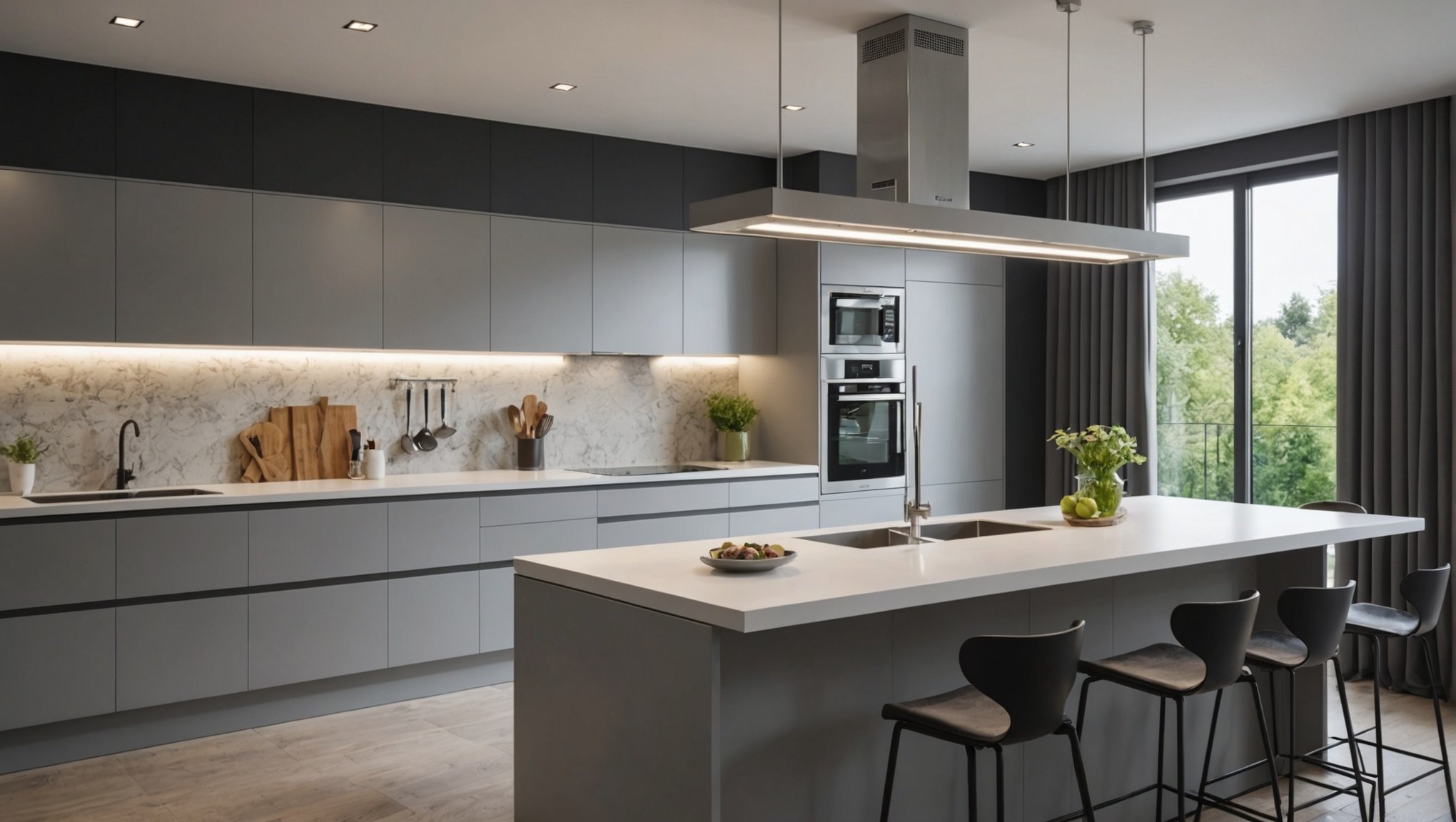If you’ve ever squinted in the harsh beams of your kitchen lights or struggled to see a recipe due to a glaring reflection, you understand the importance of well-designed lighting. Inadequate or harsh lighting can make even the simplest kitchen tasks challenging. However, crafting a lighting scheme that reduces glare on kitchen surfaces requires a blend of science, design, and art. This article will guide you through the step-by-step process that will transform your kitchen lighting and create a space that is both functional and aesthetically pleasing.
Understanding Kitchen Lighting
Before you delve into creating a lighting scheme, it’s critical to understand the basics of kitchen lighting. There are three types of lighting: ambient, task, and accent.
Also to discover : What are the optimal humidity levels for preserving food in kitchen storage?
Ambient lighting provides overall illumination for the room. It’s the general light source that replaces sunlight. This is typically achieved through ceiling fixtures, recessed lighting or LED fixtures mounted on the wall.
Task lighting is used to light up work areas like countertops, the stove, and the sink where you prepare food, wash dishes, or perform other kitchen tasks.
Also to discover : How to create a multi-sensory kitchen design for visually impaired users?
Accent lighting is focused on a specific area or object to create visual interest and highlight certain aspects of your kitchen’s design.
Understanding how these three types of lighting work together is key to creating a well-lit kitchen that minimizes glare.
Creating Ambient Lighting
Ambient lighting serves as the base layer of light in your kitchen. It should fill the room with a comfortable level of brightness without producing a harsh glare. For kitchens with low ceilings, flush-mounted fixtures are excellent sources of ambient light. If your kitchen has high ceilings, you could use chandeliers or pendant lights.
Another effective way to achieve ambient lighting is through recessed lights. These are installed into the ceiling and cast light downwards, creating a diffused light throughout the room. When selecting recessed lights, consider LED options. LED lights are energy efficient and produce less heat, reducing the risk of overheating and damage to your ceiling or cabinets.
The color of the light is also essential in managing glare. For ambient lighting, a soft white glow (2700K-3000K) will create a warm and welcoming space without glaringly bright light.
Optimizing Task Lighting
Task lighting focuses on areas where you perform specific tasks. This could be under-cabinet lighting, strip lights over the stove, or pendant lights over the kitchen island. It’s important to choose fixtures that provide enough light to safely and effectively complete your tasks without causing glare.
Under-cabinet LEDs are an excellent choice for task lighting. They can be tucked away out of sight, provide ample light for tasks, and minimize shadows and glare on your counter surfaces.
When installing task lights, you should consider the color of light that best suits your needs. A cool white (3500K-4100K) is often recommended for task lighting as it’s bright and clear.
Incorporating Accent Lighting
Accent lighting highlights specific areas or objects in your kitchen such as artwork, open shelving, or architectural features. It can also help reduce glare by providing additional layers of light and softening the intensity of ambient and task lighting.
Choosing the right fixtures and bulbs is crucial for accent lighting. Spotlights, track lighting, or wall-mounted fixtures are commonly used. Dimmable LEDs can offer flexibility, allowing you to adjust the light level to suit your needs and create a balance between functionality and ambiance.
The Role of Color in Kitchen Lighting Design
The color of your kitchen surfaces and cabinets significantly influence the way light behaves in the space. Darker colors absorb light, requiring more luminosity to achieve the same level of brightness as a lighter room. On the other hand, glossy white surfaces reflect light, which can cause a glare.
To reduce glare, consider using matte finishes for your kitchen surfaces as they diffuse light instead of reflecting it directly. If you prefer glossy cabinets or countertops, ensure your lighting scheme is well-balanced with sufficient task and accent lighting to counteract the potential for glare.
Adopting a Layered Approach
Layering is a fundamental concept in interior lighting design. It involves using a combination of different light sources at various levels to create a balanced and flexible lighting scheme. A layered lighting scheme helps you control where and how light is distributed across the kitchen, allowing you to minimize shadows and reduce glare.
By strategically placing your ambient, task, and accent lights, you can create varied visual effects and alter the mood of the room. Moreover, considering the type of bulbs, their color temperature, and the fixtures used will greatly impact the overall atmosphere and functionality of your space.
Remember, a well-designed kitchen is not just about selecting stylish cabinets or having state-of-the-art appliances. The right lighting can significantly enhance your kitchen’s design, create a warm and welcoming atmosphere, and most importantly, reduce the annoying and potentially dangerous glare on your surfaces. It’s time to step out of the shadows and bring your kitchen into the light.
Balancing Natural and Artificial Light
Natural light is an important element in kitchen lighting design. It not only helps to reduce energy costs but also creates a welcoming and pleasant atmosphere. However, depending on the time of day, season, or weather, natural light can cause a glare, especially on shiny surfaces. Therefore, it’s essential to balance natural light with artificial light to control glare and ensure consistent illumination throughout the day.
When planning your kitchen layout, consider the direction and amount of natural light that enters the space. North-facing kitchens get less direct sunlight, which often demands more artificial light. Conversely, south-facing kitchens receive abundant sunlight which may cause more glare.
To control the amount of natural light and reduce glare, consider using window treatments such as blinds, shades, or curtains. These can be adjusted to allow in the desired amount of light and prevent direct sunlight from hitting your work surfaces.
Artificial light should be implemented to complement natural light. During the day, use a combination of ambient, task, and accent lighting to balance the natural light. In the evening, your artificial lighting scheme should take over completely to provide the necessary illumination. By integrating dimmer switches into your lighting design, you can adjust the light levels to suit the time of day, the task at hand, and your personal preferences, effectively managing glare in your kitchen.
Implementing Smart Lighting Systems
In our tech-driven world, smart lighting systems are fast becoming a staple in modern kitchen design. These systems offer an array of features that can help reduce glare on kitchen surfaces while enhancing functionality and aesthetics.
Smart lights, such as LEDs, can be controlled with a smartphone, tablet, or voice-activated device, enabling you to easily adjust the brightness and color temperature of your kitchen lights. This means you can fine-tune your lighting scheme to match your activities, whether you are cooking, cleaning, dining, or entertaining guests.
Moreover, smart lights can be programmed to turn on and off at specific times or in response to natural light levels. For instance, they can be set to dim in the evening or brighten during the day, helping to maintain a consistent level of light and minimize glare.
When considering smart lighting, it’s important to understand the needs of your space and how you use it. From cabinet lighting to pendant lights over the kitchen island, each light source should be thoughtfully selected and placed to enhance your kitchen’s functionality and aesthetic appeal, while also reducing glare.
Conclusion
Designing a lighting scheme that reduces glare on kitchen surfaces can significantly improve your cooking experience and overall kitchen ambiance. By understanding the fundamentals of kitchen lighting, including ambient, task, and accent lighting, you can create a well-lit, functional, and aesthetically pleasing space.
Keep in mind the importance of balancing natural and artificial light, considering the color of your kitchen surfaces, and adopting a layered approach to your lighting design. As you select fixtures, bulbs, and decide on their placement, ensure that each element contributes to a harmonious and glare-free kitchen environment.
In this digital age, implementing smart lighting systems can make managing your kitchen lighting even more effortless. These systems offer easy control over your lighting, allowing for adjustments to brightness and color temperature, ultimately reducing glare and enhancing your kitchen’s functionality.
Remember, the right lighting can transform your kitchen space, making it not only stylish but also a comfortable space for cooking, dining, and entertaining. So, don’t neglect the role of lighting in your kitchen design and let your space shine in the best possible light.






